The Athens shoot
World of the Worlds films disaster scenes

It was cold. And a number of Group A extras shivered as they waited for the signal to begin slowly making their way towards the ferry down the street. Members of Steven Spielberg's prop crew had advised them on how to keep warm despite the drop in temperature.
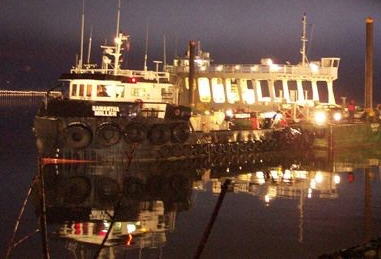
"The weather conditions were terrible," recalled Jay Anderson, one of the extras hired on for the four day shoot. "Since it was freezing, the crew advised us to dress in layers. They also gave out plastic warm up suits and hand and feet warmers."
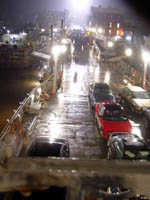
Anderson was dressed in a dark green wind breaker, brown slacks, black work boots and "some old school hat," wardrobe had issued along with props such as luggage and bicycles.
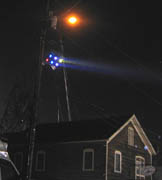
This was early December in Athens, New York, part of foothills to mountains that reached to the edge of the Hudson River. Even in early fall, cool winds blew in from the water making it a frigid place. Snow had already fallen on the first day of the shoot. And these scenes Spielberg planned for use in his upcoming block buster film, War of the Worlds, required the actors to get closer to the water's edge, part of a panicked rush for the ferry rented for the occasion.
While local newspapers reported the scene as one that would depict the mass slaughter of people seeking to flee an invasion of alien beings from outer space (part of it out of the pages of H.G. Wells' book, part out of Spielberg's imagination), Athens seemed a remarkably peaceful place, disturbed mostly by the invasion of movie people and extras that came dangerously close to outnumbering the sleepy hollow's permanent population of 1,600 people.
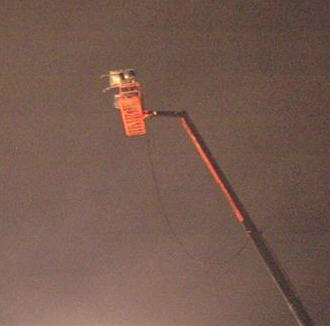
A massive glow of lights from Paramount Pictures sets and operating units illuminated the shore so that people on the far side of the Hudson River could easily see something going on here - even if they did not know it was an invasion from Mars. In fact, many of the brighter lights came from the rented ferry, recalling for local historians a time when such a service operated regularly from these shores. The foundation for the ferry slip still stood where it had for more than a century, but movie set crews had constructed a concrete platform that would allow the masses of extras - and in particular the film's stars Tom Cruise and Dakota Fanning to reach the boat before the aliens caught them.
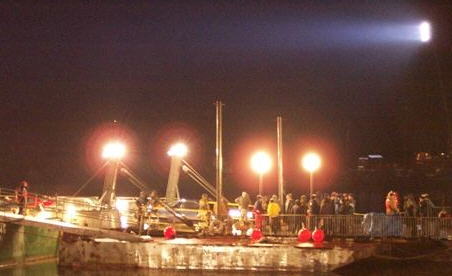
"Spielberg's guys built a concrete ramp/bridge to connect to a ferry that he had rented from Connecticut," Anderson recalled in an interview in January.
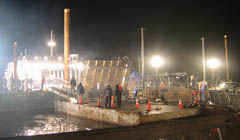
The aliens in this case were tall towers of red and blue lamps around which special effects crews in Los Angeles would build the actual aliens.
The Spielberg movie was a kind of old fashioned circus that seemed to stir up excitement wherever it went, and the movie was making use of a number of locations up and down the east coast, from as far south as Virginia to nearby Connecticut, with stops in Newark, Bayonne, Howell Township, Staten Island and other places. Indeed, the same white tents that helped process the more than 1,000 movie extras needed for the scenes filmed here in Athens were those until a few weeks earlier had stood under the shadow of the Bayonne bridge, issuing clothing and food, getting everybody ready for a performance that would blast across the big screen in June with the release the movie.
Anderson and the other extras also wore clothing much the same as scene on sets in Bayonne or along the highway scenes in Staten Island, wearing hooded sweat shirts or knit caps, waiting for that signal that would begin their panicked flight, many of them stamping their feet to keep the chill out or clutching their chests, each breath emitting steam Spielberg needed no special effects to achieve.
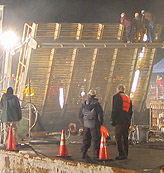
As in Bayonne and elsewhere, the movie crews had wet down the streets of the small New York hamlet to get the additional effect of reflected lights while shooting. This also seemed to make the streets slicker to walk on and the extras a little more careful how they moved. No one wanted to fall down on a sudden stretch of black ice while the camera on them. But the cold hardly dampened anyone's spirits. Even the early arrival of snow only made the people more festive, as if Christmas had arrived three weeks early. Some even sang carols between shoots.
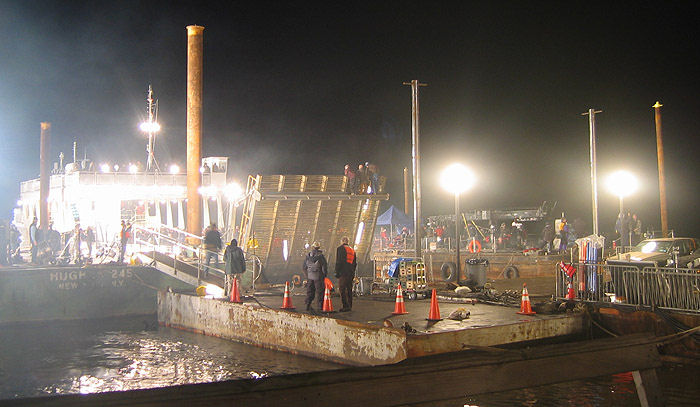
Just why Spielberg had selected this place to have his aliens attack remains a matter of speculation. None of the extras interviewed for this account could say why. Set Coordinator for Paramount Pictures, Kay Michaels did not respond to questions when contacted for comment. The small hamlet was much more easily closed off than was the case in Bayonne or even Staten Island - although a handful of local reporters still tested security by attempting to invade the shoot, their arrest recorded in the local newspapers police blotter.
As was Bayonne, Athens was named for a city located on the far side of the Atlantic Ocean - part of a late 19th century architectural revolution as the gothic structures of pre-Civil War slowly gave way to classical models. The town was deliberately named as part of that revival, and indeed, many of the gothic and classical designs can only be found in the more remote rural portions of the New York State after new design movements and the invention of the earth moving equipment during World War Two reshaped the urban areas with still more modern designs. Once named Esperanza, Athens was supposed to become a market town for farmers farther west in the state. A rail line since named "the white elephant line" for its inability to sustain itself economically was even installed for that purpose. But the hamlet did not flourish or grow in the way many expected - perhaps adding to its attractiveness for Spielberg.
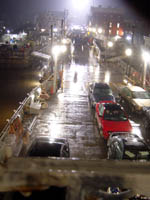
The filming here for the movie brought with it several ironies Spielberg most likely didn't know about. For instance, within walking distance (well, a short car ride anyway), Spielberg could have visited sites near Athens and Bayonne where Elco Boat Works set up shop. The electric boats - early in the 20th century could be seen sailing the Hudson River here and Newark Bay back in Bayonne by local residents.
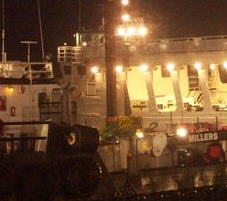
More ironic than coincidental was Paramount's call for people of color and people of other ethnic backgrounds to become part of the mass slaughter the Martians would reap - since Spielberg apparently did not wish to have the film merely maim and mangle the mostly white populations of extras who had come out in his service. Although the 2000 census showed Athens with less than 20 black residents (reflecting the overall make up of that rural area), New York State - in particular Greene County in which Athens was located played an important role in the Underground Railroad that brought escaping slaves to safety from the distant south. In the 1970s, Charles Stuart, then a resident of Athens, became the county's first black historian, someone who set out to collect the rapidly fading tales of those slaves that made their way north.
What drew Spielberg here is likely locked up in the creative vault of his brain. Perhaps some subconscious part of him recognized the gothic and classic details, but most likely he simply saw a landscape that was very similar to that which was depicted in the Wells novel, including access to the rail line he needed for the burning train he intended to film, and access to the river where he could have the ferry disembark.
Anderson had heard about the call for movie extras via his home town radio station in Poughkeepsie, seeking up to 1,000 people for filming scheduled to start on Dec. 6. The scenes, he was told, involved a ferry loaded with cars, a fiery train, hundreds of people seeking to get on the ferry ahead of the march of the invading Martians. The casting call was held at the local community center in Athens.
"Basically all that was said is that they needed 1,000 extras of all ages for a mass mob scene," Anderson said. "The location was real simple: your typical small town with amazing views of the Hudson River."
Paramount Studios had leased the use of Athens Riverfront Park and brought the ferry in from Connecticut.
To simulate the disaster, film crews floated cars without engines in the river. These were apparently initially stored at the former Military Ocean Terminal in Bayonne, where Spielberg used studios for many of the interior sets and set up a special effects unit that helped create many of the effects for nearby shoots such as the wrecked vehicles filmed on Ferry Street in Newark, the red weed used both in the Howell Township shoot and the Staten Island shoot.
Tom Malgapo, president of the Central Jersey Mustangs and Fords Club - who was hired to fix up some of the auto repair sets at two locations in Bayonne - said he had seen a number of cars stored in Bayonne and had even seen the logo for Sutton Police being installed on several police cars, one of the imaginary towns in which the film was set.
"Apparently that's what the town will be called in the film," Malgapo surmised.
Filming started about 3 p.m. on each day and sometimes lasted as long as 15 hours, Anderson recalled.
The crowd, he said, was instructed to move towards the ferry as lights posted onto of high towers simulated the attack of alien tripods. This was a scene that featured a burning train rolling towards a road crossing, and Tom Cruise carrying Dakota Fanning to safety just as the draw bridge closes stopping additional human traffic onto the ferry, leaving behind many of the extras to be destroyed by the aliens.
Anderson said about 800 extras were involved in this shoot, representing a mass of people fleeing the alien tripods, many seeking to escape via the ferry.
"We all started off at the top of 2nd Street," Anderson said. "They had about 14 real army soldiers with two humvees and huge light rigged up in the sky. We slowly head towards the ferry and came to a rail road crossing (which Spielberg's crew built) to watch as a burning train passed."
Anderson was told this would be additionally enhanced later by special effects.
"We all played people driven from our homes, some trying to find loved ones, others looking for shelter and headed to the ferry," Anderson said.
In this sequence, Spielberg makes an allusion to the post 9/11 scenes in which people are posting pictures of the missing, pictures stretched along a fence with the hope someone might have seen the missing people.
At one point, Anderson and his group were told to start moving when a flock of birds flew out of the trees.
"We proceeded to move and then they cued the aliens and we ran like hell," he said.
During the shoot, staff members reported losing several very realistic dummies in the river.
"They were very real looking," one staff person said during a brief interview. "They were also extremely valuable."
Anderson's portion of the shoot took about three nights, although the extras were also asked to come in a day early for a rehearsal. But he would go back and repeat the experience in a heart beat.
Although Spielberg and Cruise were not initially on the set when Anderson arrived - operations were being run by one of Spielberg's chief assistants, an Englishman named Adam, once Spielberg arrived he became a cheer leader for them, doing as much as possible to keep their spirits up during the long nights of shooting.
Spielberg apparently arrived by helicopter in the company of Cruise.
"They said a lot of hellos and shook a lot of hands," Anderson said. "I told them both that I was happy to be part of the film. Spielberg made everyone feel pumped up. I mean he really made everyone there feel like it was our own movie. He's not a stuck up Hollywood prick. He came into the crowds and conversed with everybody."